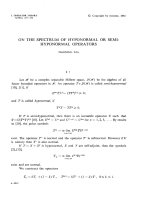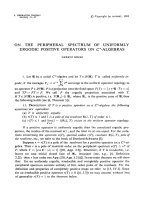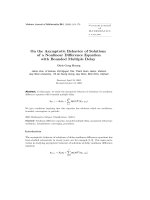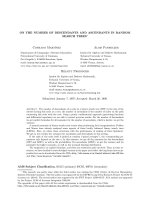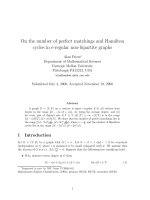Báo cáo toán học: "On the crossing number of Km,n" potx
Bạn đang xem bản rút gọn của tài liệu. Xem và tải ngay bản đầy đủ của tài liệu tại đây (87.21 KB, 6 trang )
On the crossing number of K
m,n
Nagi H. Nahas
Submitted: Mar 15, 2001; Accepted: Aug 10, 2003; Published: Aug 21, 2003
MR Subject Classifications: 05C10, 05C35
Abstract
The best lower bound known on the crossing number of the complete bipartite
graph is :
cr(K
m,n
) ≥ (1/5)(m)(m − 1)n/2(n − 1)/2
In this paper we prove that:
cr(K
m,n
) ≥ (1/5)m(m − 1)n/2(n − 1)/2 +9.9 × 10
−6
m
2
n
2
for sufficiently large m and n.
1 Introduction
Determining the crossing number of the complete bipartite graph is one of the oldest
crossing number open problems. It was first posed by Turan and known as Turan’s brick
factory problem. In 1954 , Zarankiewicz conjectured that it is equal to
Z(m, n)=n/2(n − 1)/2m/2(m − 1)/2
He even gave a proof and a drawing that matches the lower bound, but the proof was
shown to be flawed by Richard Guy [1]. Then in 1970 Kleitman proved that Zarankiewicz
conjecture holds for Min(m, n) ≤ 6 [2]. In 1993 Woodall proved it for m ≤ 8,n ≤ 10
[3]. Previously the best known lower bound in the general case was the one proved by
Kleitman [2] :
cr(K
m,n
) ≥ (1/5)(m)(m − 1)n/2(n − 1)/2.
Richter and Thomassen discussed the relation between the crossing numbers of the com-
plete and the complete bipartite graphs [4].
the electronic journa l of combinatorics 10 (2003), #N8 1
2 A new bound
We will start by giving definitions that will be used throughout the paper. They are taken
from Woodall[3] and Kleitman [2].
Definition 1 Two edges e
1
and e
2
are said to have a crossing in a drawing D of K
m,n
if
e
1
can be closed by a curve disjoint from e
2
connecting the two endpoints of e
1
and such
that there are points of e
2
both inside and outside the closed curve.
Definition 2 The crossing number cr
G
of a graph G is the smallest crossing number of
any drawing of G in the plane, where the crossing number cr
D
of a drawing D is the
number of non-adjacent edges that have a crossing in the drawing.
Definition 3 A good drawing a graph G is a drawing where the edges are non-self-
intersecting where each two edges have at most one point in common, which is either
a common end vertex or a crossing.
Clearly a drawing with minimum crossing number must be a good drawing.
Let A be one partite and B the other partite. The elements of A are a
1
,a
2
,a
3
, ,a
m
,
and the elements of B are b
1
,b
2
, ,b
n
.InadrawingD,wedenotebycr
D
(a
i
,a
k
)the
number of crossings of arcs, one terminating at a
i
, the other at a
k
and by cr
D
(a
i
)the
number of crossings on arcs which terminate at a
i
:
cr
D
(a
i
)=
n
k=1
cr
D
(a
i
,a
k
)
The crossing number of the drawing D is therefore:
cr
D
=
n
i=1
n
k=i+1
cr
D
(a
i
,a
k
)
Let us define :
Z(m)=m/2(m − 1)/2.
Let S
∗
n
be the set of the (n − 1)! different cyclic orderings of a set V
n
of n elements. (The
significance of cyclic ordering is that 01234 is considered as being the same as 34012 or
12340). If z
1
and z
2
belong to S
∗
n
then the distance d(z
1
,z
2
) is the minimum number of
transpositions between adjacent elements in the cyclic ordering necessary to turn z
1
into
z
2
.Ifa belongs to S
∗
n
then ¯a denotes the reverse ordering of a. For example, in S
∗
7
,if
a = 0354162, then ¯a = 0261453. The antidistance
¯
d(a, b) between two elements a and b
is the distance between ¯a and b (or between
¯
b and a). Woodall [3] gave a detailed proof
of the two following propositions:
Theorem 1 If a ∈ S
∗
n
, then
¯
d(a, a)=Z(n).
Theorem 2 In a drawing D of K
2,n
on two sets {x, x
} and V
n
, let the clockwise orders
in which the edges leave x and x
to go to V
n
be the elements a and b of S
∗
n
. Then
cr
D
≥
¯
d(a, b), and if n is odd then cr
D
is of the same parity than
¯
d(a, b).
the electronic journa l of combinatorics 10 (2003), #N8 2
Kleitman proved the following equalities:
Theorem 3
cr(K
5,n
)=4n/2(n − 1)/2 (1)
cr(K
6,n
)=6n/2(n − 1)/2. (2)
From this he deduced that
cr(K
m,n
) ≥ (1/5)(m)(m − 1)n/2(n − 1)/2 (3)
in the following way: There are
m
5
K
5,n
which are subgraphs of K
m,n
, with the partite
with n vertices in the K
5,n
being B.Letσ be the sum over all such K
5,n
of the number
of crossings that each of these K
5,n
containinadrawingD. Obviously σ ≥
m
5
Z(5,n).
Each crossing appears in exactly
m−2
3
K
5,n
. Therefore
cr(K
m,n
) ≥
m
5
Z(5,n)
m−2
3
cr(K
m,n
) ≥ (1/5)(m)(m − 1)n/2(n − 1)/2
We will obtain a small improvement on this lower bound for large values of n,withm ≥ 7,
by proving that there is a number of K
5,n
subgraphs of K
m,n
which must have more than
Z(5,n) crossings in any drawing of K
m,n
The cyclic ordering of the edges around each b
j
∈ B can be considered as a cyclic
ordering of the elements of A, and therefore as an element of S
∗
m
.
Suppose we have a K
2,m
which first partite is {u
1
,u
2
} and second partite is {u
1
, ,u
m
}.
And let c(u
1
) denote the cyclic ordering of the edges around u
1
,andc(u
2
) denote the cyclic
ordering of the edges around u
2
. Woodall [3] proved the following theorem:
Theorem 4 If a good drawing of K
2,m
has r crossings, there is a sequence Seq(u
1
,u
2
) of
r transpositions between adjacent elements in c(u
1
), such that if we apply this sequence
to c(u
1
) we obtain ¯c(u
2
), and there is a crossing in the K
2,2
subgraph of K
2,m
on vertices
u
1
,u
2
,u
i
,u
i
if and only if exactly one of the transpositions takes place between elements
u
i
and u
i
in Seq(u
1
,u
2
). (In a good drawing a K
2,2
can have one crossing at most.)
We can now prove our first lemma:
Lemma 1 In any K
2,7
subgraph of K(m, n) where the two vertices with 7 edges have the
same cyclic ordering of edges, there is a K
2,4
subgraph which has 6 crossings.
Proof :Let A
beasubsetof7elementsofA,sayw
1
,w
2
, ,w
7
(for every l, w
l
= a
k
for
some k). Let {b
k
,b
l
} be one partite of a K
2,7
subgraph G of K
m,n
and let A
be the second
partite. Now suppose c(b
k
)=c(b
l
)inG.LetW (b
k
,b
l
)bethesetofpairs{w
i
,w
i
} of
elements of A
such that there is a transposition exchanging w
i
and w
i
in Seq(b
k
,b
l
)inthe
drawing of G.Letw
y
be one element of A
,andletA
∗
= A
\{w
y
}.LetA
1
be the set of
the electronic journa l of combinatorics 10 (2003), #N8 3
elements a
x
of A
∗
such that {a
x
,w
y
}∈W (b
k
,b
l
)andA
2
= A
∗
\ A
1
. It is clear that every
triple {w
y
,w
z
,w
z
} reverses its ordering between c(b
k
)and¯c(b
l
)=¯c(b
k
), which implies
that either all three pairs {w
z
,w
z
}, {w
y
,w
z
}, {w
y
,w
z
} belong to W(b
k
,b
l
)orexactlyone
of these pairs belong to W (b
k
,b
l
). Therefore, if a pair of elements {w
z
,w
z
}⊂A
either
has both of its elements in A
1
or has both of its elements in A
2
,then{w
z
,w
z
}∈W (b
k
,b
l
).
Either Card(A
2
) ≥ 4ornot. IfCard(A
2
) ≥ 4, every 4-subset of A
2
has 6 2subsets that
belong W (b
k
,b
l
). If Card(A
2
) < 4, Card(A
1
) ≥ 3, and every 3-subset of A
1
has 3 2-
subset belong W(b
k
,b
l
). Let A
1
be such a subset. Then A
1
U{w
y
} is a 4-subset that has
6 2-subsets in W (b
k
,b
l
). Therefore there exists a subgraph χ of G, having 6 crossings,
where one partite is {b
k
,b
l
} and the other partite is a 4-subset.✷
There are 3 distinct K
2,5
in G that have χ as a subgraph so each of them must have
at least 6 crossings.
We will also need the following lemma :
Lemma 2 Let D
5,z
be an arbitrary drawing of some K
5,z
and let t
0
be an element of the
partite F with z elements and let T be the set of all elements of F having the same cyclic
ordering of edges incident on them as t
0
. The elements of T are t
0
,t
1
, Letη be the
number of pairs {t
k
∈ T,t
k
∈ T } such that cr
D
5,z
(t
k
,t
k
) ≥ 6 ≥ Z(3, 5) + 2.
Then Z(5,z)+2η ≤ cr
D
5,z
.
Proof:Let h(t
k
) be the sum of the number of crossings of the edges of t
k
with edges
not incident on any vertex of T .Lett
min
be the element of T such that h(t
min
) ≤ h(t
k
)
for all t
k
∈ T. Using a construction used by Kleitman,[2] (”Constructive Argument ”
p319), we can obtain from D
5,z
another drawing D
5,z
where the position of the edges
not incident on a vertex of T remains unchanged, and h(t
k
)=h(t
min
) for all k,and
cr
D
5,z
(t
k
,t
k
)=Z(3, 5). (The construction mainly consists at placing t
k
close to t
min
and letting the edges incident on t
k
follow the path of the corresponding edges of t
min
.)
Therefore
Z(5,z)+2η ≤ cr
D
5,z
+2η ≤ cr
D
5,z
Let θ be the number of distinct K
2,5
subgraphs of K
m,n
having at least 6 crossings
in D and such that the partite with 2 elements is a subset of B, and the partite with 5
elements is a subset of A,andletσ have the same definition as it had in the proof of (3).
Then σ ≥
m
5
Z(5,n)+2θ.
In the following lemma, A
is defined in the same way as in the proof of Lemma 1.
Lemma 3 Let λ be the number of distinct pairs of elements of B having the same cyclic
ordering of edges incident on an element of A
. Then, if n ≥ 2 × 6!, we have
λ ≥ (6!)
n/6!
2
the electronic journa l of combinatorics 10 (2003), #N8 4
Proof : Let α
1
and α
2
be two distinct elements of (S
∗
7
)andletn
α
1
be the number of vertices
of B having the cyclic ordering of their edges equal to α
1
and let n
α
2
be the number of
vertices of B having the cyclic ordering of their edges equal to α
2
.Ifn
α
1
− n
α
2
≥ 2, it is
always possible to reduce the number of pairs of vertices having the same cyclic ordering
of edges by assigning α
2
to one of the vertices which cyclic ordering of edges was α
1
.So
the minimum possible number of pairs of vertices having the same cyclic ordering of edges
can only occur if |n
α
1
− n
α
2
| =1or|n
α
1
− n
α
2
| = 0 for all {α
1
,α
2
}⊂S
∗
7
. Therefore
λ ≥ (6!)
n/6!
2
Let ν be the minimum number of K
2,5
subgraphs of a K
2,7
whose number of crossings
must be at least 6 when cyclic ordering of the 7 edges around the vertices of the partite
with 2 elements are identical. As noted previously ν =3.
m−5
2
is the number of K
2,7
subgraphs of K
n,m
in which a given K
2,5
appears.
θ ≥
m
7
λν
m−5
2
From the above we can deduce a new lower bound on the crossing number of K
m,n
.We
have:
cr(K
m,n
) ≥
σ
m−2
3
σ ≥
m
5
Z(5,n)+2θ
cr(K
m,n
) ≥
m
5
Z(5,n)+2λν
m
7
/
m−5
2
m−2
3
(4)
For sufficiently large m and n, we therefore have :
cr(K
m,n
) ≥ (1/5)m(m − 1)n/2(n − 1)/2 +9.9 × 10
−6
m
2
n
2
3 Conclusion
In this paper, we have proved a new lower bound on the crossing number of K
m,n
by
proving the existence of certain non optimal drawings of K
5,n
subgraphs in any drawing
of K
m,n
. By proving the existence of other non optimal drawings, we might perhaps get
improvements on the current lower bound. So this method could be one possible way to
progress on Zarankiewicz conjecture.
the electronic journa l of combinatorics 10 (2003), #N8 5
References
[1] R. K. Guy, The decline and fall of Zarankiewicz’s theorem, Proof techniques in Graph
Theory, F. Harary, ed. Academic Press, New York (1969), 63–69.
[2] Daniel J. Kleitman, The crossing number of K
5,n
, J. Combinatorial Theory 9 (1970),
315–323.
[3] D. R. Woodall, Cyclic-Order Graphs and Zarankiewicz’s crossing number conjecture,
J. Graph Theory 17 (1993), 657–671.
[4] R. Bruce Richter, Carsten Thomassen, Relations between crossing numbers of com-
plete and complete bipartite graphs, The American Mathematical Monthly 104 (1997),
131–137.
the electronic journa l of combinatorics 10 (2003), #N8 6


